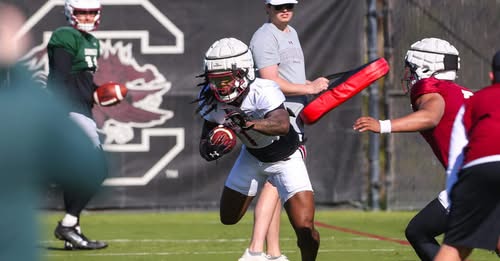Rahsul Faison, the talented running back for the South Carolina Gamecocks, has recently returned to practice following a brief absence due to a shoulder injury, reigniting hope among fans and teammates alike. Faison’s injury, which occurred during a recent scrimmage, was minor but required a careful approach to ensure full recovery before the start of the 2025 season. While the shoulder bruise was not considered severe, it temporarily sidelined Faison from team activities and prompted close monitoring by the South Carolina coaching staff and medical team. Head coach Shane Beamer confirmed that Faison’s absence was strictly injury-related and was not tied to any eligibility issues or administrative matters, emphasizing the importance of prioritizing player health and readiness over rushing an athlete back onto the field.
The timing of Faison’s return is particularly significant, as it coincides with a period of heightened scrutiny regarding his NCAA eligibility. As one of South Carolina’s top offensive talents, Faison’s ability to compete in the upcoming season is crucial for both his personal career trajectory and the team’s offensive strategy. The NCAA is currently reviewing Faison’s eligibility status, and while he has been allowed to participate in training camp under an emergency waiver, a final decision has not yet been issued. This pending determination adds a layer of uncertainty to Faison’s season, though both the player and the Gamecocks program remain optimistic about a favorable ruling.
Faison’s return to practice has been marked by a careful, measured approach. Coaches have emphasized limiting contact during initial drills to prevent aggravating the shoulder while still allowing him to regain timing, rhythm, and conditioning. Early reports from practice sessions indicate that Faison has responded well to the controlled workload, demonstrating both mobility and explosiveness in non-contact drills. His presence on the field has been a morale boost for the team, with teammates noting his enthusiasm, leadership, and commitment to the program despite recent setbacks.
From a medical standpoint, shoulder injuries in running backs require diligent management, given the demands of the position. Faison’s role in South Carolina’s offensive scheme involves frequent contact, rapid direction changes, and the ability to absorb tackles from multiple angles. Even minor injuries in this area can lead to lingering soreness or diminished performance if not properly rehabilitated. The Gamecocks’ medical staff has been working closely with Faison to ensure that his shoulder strength, flexibility, and stability are fully restored. This process includes a combination of targeted physical therapy, progressive strength training, and monitored on-field drills to assess his readiness for full competition.
While injury recovery is one aspect of Faison’s current status, his NCAA eligibility remains a focal point for both the program and fans. Faison’s case highlights the complex interplay between collegiate athletics, eligibility regulations, and player rights. The NCAA requires thorough documentation and compliance review before granting waivers or confirming eligibility, ensuring that athletes meet all criteria related to prior competition, academic standing, and adherence to program regulations. In Faison’s situation, the NCAA has received the necessary documentation to evaluate his eligibility, but a formal ruling has yet to be issued. The timing of this decision is critical, as it determines whether Faison can participate fully in the upcoming season, affecting both game planning and recruiting strategies for South Carolina.
The Gamecocks’ coaching staff has remained cautiously optimistic throughout the process. Shane Beamer has publicly expressed confidence in Faison’s return to health and ability to contribute once the eligibility ruling is finalized. Beamer has emphasized that the team is preparing for the season with the assumption that Faison will be cleared, allowing offensive coordinators to integrate him into practice schemes and game plans. This proactive approach ensures that the team maintains competitive readiness regardless of any administrative delays or last-minute decisions.
From a strategic perspective, Faison’s presence is integral to South Carolina’s offensive identity. Known for his combination of speed, vision, and power, Faison has the ability to change the dynamics of a game. His skill set allows for versatility in play-calling, ranging from outside zone runs to inside power plays and third-down passing options out of the backfield. Having a player of his caliber available can also open opportunities for other offensive weapons, as defenses are forced to respect his ability to break tackles and generate explosive plays. The anticipation surrounding his return underscores the significance of his role, not just as a contributor but as a game-changing athlete capable of influencing outcomes on multiple levels.
Faison’s journey to this point has not been without challenges. Like many elite college athletes, he has navigated the pressures of high-level competition, rigorous training schedules, and the scrutiny that comes with being a standout performer. The combination of physical demands, administrative hurdles, and public attention requires a level of resilience and focus that goes beyond natural talent. Faison’s handling of his recent shoulder injury and the ongoing NCAA review demonstrates maturity and commitment, reflecting both his dedication to the Gamecocks program and his professional aspirations.
The reaction from fans and analysts has been largely supportive, with many emphasizing the importance of patience and due diligence in both injury recovery and eligibility matters. Social media discussions, fan forums, and sports commentary have highlighted Faison’s potential impact on South Carolina’s season while acknowledging the need for caution to avoid long-term setbacks. The consensus among observers is that a fully healthy and eligible Rahsul Faison could significantly elevate the Gamecocks’ offensive performance, potentially translating to more competitive outcomes against high-ranking opponents.
Looking ahead, the timeline for Faison’s full integration into the active roster will depend on two primary factors: continued recovery from his shoulder injury and the NCAA’s eligibility determination. Coaches have structured practice sessions to gradually increase intensity, allowing Faison to test his shoulder under progressively challenging conditions while minimizing the risk of reinjury. Concurrently, the NCAA’s review process will determine his official status, providing clarity for the team, fans, and media. The interplay of these two factors creates a situation that requires careful management, balancing urgency with prudence to ensure that Faison is fully prepared both physically and administratively for the season ahead.
Beyond the immediate implications for South Carolina football, Faison’s situation also serves as a case study in how collegiate athletic programs manage player health, compliance, and communication. The transparency with which the Gamecocks have addressed his injury and eligibility concerns reflects a broader trend in college sports toward proactive engagement with players, regulatory bodies, and the public. By keeping stakeholders informed while protecting the athlete’s well-being, programs like South Carolina demonstrate a commitment to ethical and effective management practices, balancing competitive ambitions with responsible oversight.
In conclusion, Rahsul Faison’s return to practice marks a positive development for South Carolina football, signaling recovery from a minor shoulder injury and readiness to contribute to the team’s offensive efforts. While his NCAA eligibility remains under review, the proactive approach of both the athlete and the program provides a framework for optimism. Faison’s combination of talent, resilience, and leadership underscores his importance to the Gamecocks, and his eventual participation in the upcoming season could have significant ramifications for team performance, game strategy, and program momentum. As fans await official announcements regarding his eligibility, the return of Rahsul Faison to the field represents a pivotal moment in South Carolina’s preparation for the 2025 season, blending athletic excellence with careful management to maximize both player potential and team success. The situation highlights the intricate balance between injury recovery, regulatory compliance, and strategic planning in collegiate athletics, offering insights into the multifaceted nature of managing elite-level student-athletes in today’s competitive sports landscape.



